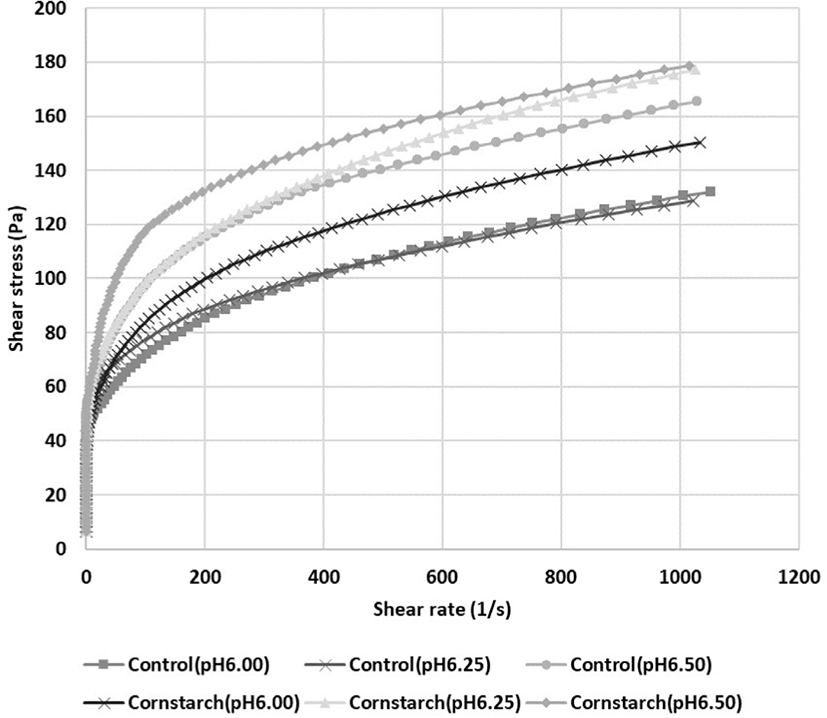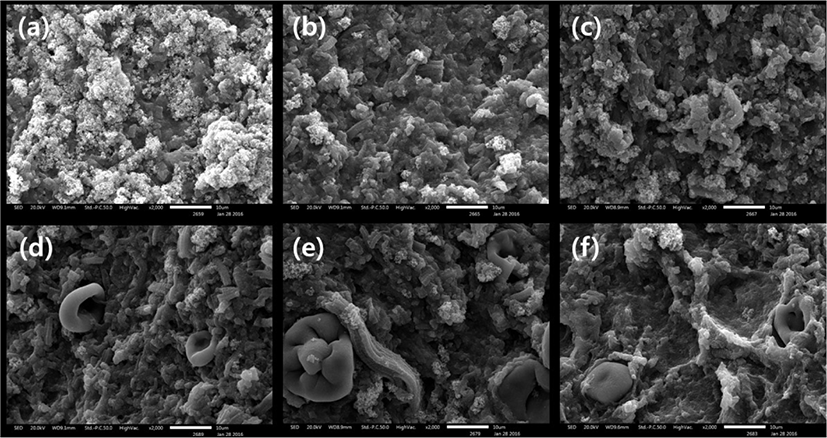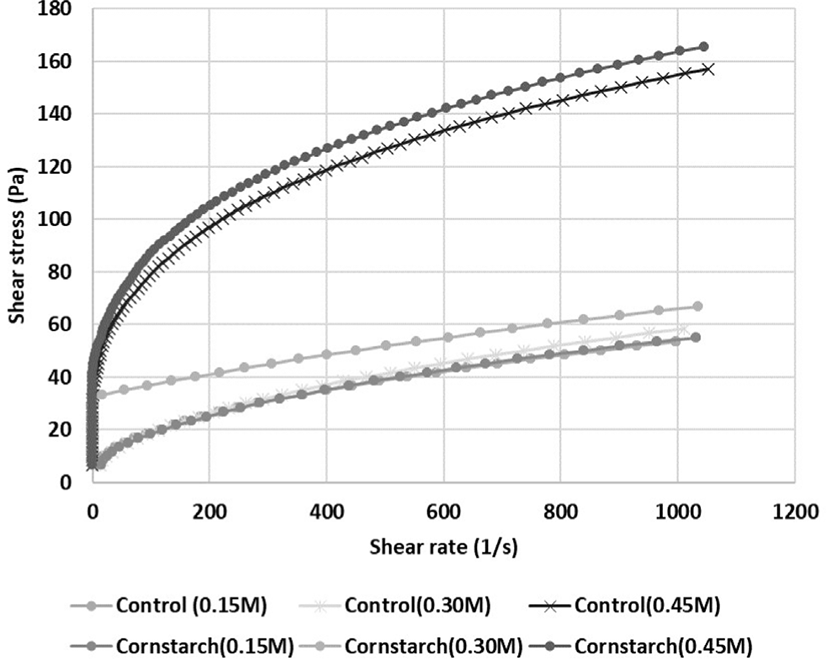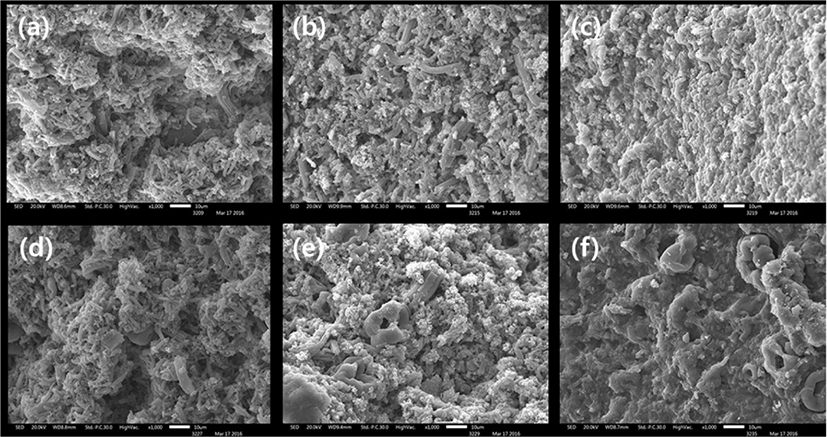Introduction
Myofibrillar proteins (MP) are known to influence functional properties, such as water-holding ability, emulsifying ability and gelling properties (Westphalen et al., 2006). Cross-linking of proteins is performed via ionic strength, hydrogen bonds, disulfide bonds, and hydrophobic bonds (Ni et al., 2014). Especially, pH and salt levels can affect water-holding capacity and water binding ability of MP gels. The pH values, which are apart from the isoelectric point, can cause electrostatic repulsion among myosin molecules and increase the mobility of myosin (Bertram et al., 2004). As increasing the pH values, myofibril could be swelled and it indicates the increasing the water-holding capacity (Westphalen et al., 2005). According to the study by Westphalen et al. (2005), the possibility was suggested that hydrogen bonding between protein and water can increase at high pH value. When sodium chloride is added to meat products, negative charges of protein are increased due to strong bonding of protein with chloride ion. These negative charges on protein can cause the repulsion among myofilaments, resulting in swelling of myofibrils and increasing of binding ability (Ruusunen and Puolanne, 2005).
Starch is commonly used as a binder or extender in the food system. Its application to meat products can improve functional properties such as gel strength and water-holding ability with a low cost (Kim and Lee, 1987). The structure of starch consists of abundant hydroxyl group for binding water molecules through hydrogen bonding, resulting in thickening and gelling properties of food products (Ramírez et al., 2011). From the initial temperature of gelation, the degree of collapse of cornstarch molecules is increased with increasing temperature. Cornstarch gels are composed of granule remnants at high temperature (Shim and Mulvaney, 2001). The addition of modified waxy maize starch improved physical properties of beef sausages and make them more acceptable than those without starch (Mohammadi and Oghabi, 2012). Starch could replace animal-fat in meat products to develop low-fat meat products (LFMPs), resulting in low calorie and without having detrimental effects on their physicochemical properties. Extrusion and phosphorylation of rice starch has been reported to contribute textural properties and sensory attributes of low-fat suasages (Limberger et al., 2011). However, effects of pH and salt on gel properties of pork MP added with cornstarch remain unclear. Thus, the objective of this study was to evaluate quality characteristics of pork MP added with cornstarch as affected by different pH values and salt concentrations.
Materials and Methods
Cornstarch was provieded by the company (Tureban, Goyang, Korea). Sodium chloride was purchased from private company (Daejung Chemicals & Materilas, Siheung, Korea). Pork loin (Longissimus dorsi, Landrace×Yorkshire, graded A) was purchased from a local market (Samho, Gwangju, Korea). After removing visible fat and connective tissues, pork loin was cut to cubes and trimmed pork loin was stored at –50°C freezer until utilized.
Pork loin was mixed with 0.1 M NaCl and 50 mM phosphate buffer solution and homogenized using a mixer (HR-2160, Phillips, Seoul, Korea) for 90 s. After three times of centrifugation (Supra 22K, Hanil, Seoul, Korea), precipitate of protein slurry was obtained. Precipitate was filtered with cheesecloth using 0.1 M NaCl buffer, follwed by centrifugation at 1,660×g for 15 min. The precipitate was collected and considered as myofibrillar protein. Before MP was mixed with buffer solution and loaded into vial tubes (Fisher Scientific, Leicestershire, UK), its final pH value (6.00, 6.25, and 6.50) and salt concentration (0.15, 0.30, and 0.45 M) were adjusted using buffer solution. Treatments with the addition of cornstarch were mixed with 1.0% of cornstarch. These vials were heated from room temperature to 80°C using a water bath (WB-22, Daihan Scientific, Seoul, Korea). Cooked samples were then chilled in an ice water and stored at 4°C refrigerator overnight.
Cooking yield (CY) was calculated based on weights before and after cooking of protein mixture. CYs were averaged for five different samples. These samples were heated from 20 to 80°C using the water bath. Gel strength of MP gel in the vial was measured using Instron (Model 3344, Instron Coporation, USA). The head speed was set at 500 mm/min and the first breaking peak (gf) was checked per each five sample.
Samples were taken before heating the MP mixtures. A cylinder type rotational rheometer (RC30, Rheotec Messtechnik, Dresden, Germany) was used to evaluate shear stress. Probe container was prepared by loading MP mixtures. Shear stress was increased from 0 to 600 /s. Data were arranged by graph using excel program.
MP heat-induced gels with or without cornstarch were cut into cubes at size of 3×3×3 mm and incubated with 2.5% glutaraldehyde and 0.1M phosphate buffer solution at 4°C overnight. MP samples were rinsed with 0.1 M phosphate buffer solution three times. Osmium tetroxide (pH 7.00) solution was then used to treat these samples. After rinsing with 0.1 M phosphate buffer solution three times, various concentrations of ethanol were used to dehydrate these samples. MP samples were then dehydrated with acetone solution. Gold was then used to coat these samples using a 108 auto sputter coater (Cressington Scientific Instruments, Watford, UK) followed by microstructure observation (JSM-6610LV, JEOL, Tokyo, Japan). Microscopy images were captured at 2,000×magnification.
Results and Discussion
Table 1 shows results of CY (%) and gel strength of MP gels at different pH values. Since pH values were not interacted with the addition of corn starch on gel strength, data were pooled by cornstarch and pH value. The addition of cornstarch increased the CY (p<0.05). However, no differences in gel strength among treatments were observed (p>0.05). As compared with various pH values, MP gels at pH 6.00 had lower CY and gel strength values than those at pH higher than 6.0 (p<0.05). Liu et al. (2010) found that pH above isoelectric point of meat protein can make myosin expand and bound with abundant water molecules due to the charged group with repulsive forces. In addition, water-holding capacity of pork myofibril gel is increased when pH is increased from 5.5 to 7.0, although no difference at pH above 7.0 up to 9.0 were found (Liu et al., 2008). This is because when pH values is increased to be higher than the isoelectric point, and the intensity of negative charge is enlarged, resulting in electrostatic repulsion of myosin molecules. This phenomenon can lead to the binding of many water molecules and the appearance of space for hydration. Bertram et al. (2004) reported that gelling properties of MP was depended on pH values, as gelation is increased with increasing pH from 5.4 to 7.0. Lesiów and Xiong (2003) reported that chicken breasts with pH increased up to 6.30 showed to improve gel strength and those with pH above 6.30 started to show decrease of gel strength. The high amount of cornstarch might prohibit the cross-link of proteins by disturbing interactions among proteins which could weaken the gel strength (Xu et al., 2018). Since the transition temperature of cornstarch is independent of pH value, there is no differences according to pH value (Shim and Mulvaney, 2001). As the isoelectric point of cornstarch was found at pH 2.6 (Taylor, 2013), the increment of pH value above 2.6 showed the high water-holding ability.
Viscosity values of MP mixtures added with or without cornstarch at different pH values are shown in Fig. 1. With increasing pH value, shear stress of MP gel was also increased. According to results of dynamic rheological properties of myosin reported by Liu et al. (2008), myosin with pH values higher than the isoelectric point increased the mobility of protein molecules, resulting in increased viscoelasticity of myofibril mixture. The addition of cornstarch increased the shear stress compared to the treatment without cornstarch. This result might be partially due to high viscosity of glucose chains of cornstarch with entangled structures (Hirashima et al., 2005).

Microstructures of MP gels with or without cornstarch at different pH values are shown in Fig. 2. In microstructure of MP gel added with cornstarch, swelled cornstarch was observed among aggregated protein structures. Such expanded structure of cornstarch resulted in higher CY and shear stress, as compared to those without cornstarch. After the addition of starch granules to MP gels, starch swelled and interpenetrated between MP molecules, resulting in high viscoelastic properties (Fan et al., 2017). At different pH values, the arrangement of globular structures as a specific structure of pork MP gels was well-ordered and uniform. These pH values were not enough different for changing the microstructure of MP gels. Liu et al. (2008) reported that MP gels at pH 6.5 showed compact structure with uniform and bead-like particles, indicating that negative charges could induced unfolding of myosin before aggregation and lead to fine gel matrix.

Effects of salt concentrations on CY of MP gel are shown in Table 2. In accordance with previous experiment, the addition of cornstarch improved the CY (p<0.05). It is known that amylopectin from cornstarch is associated with swelling ability. It can increase CY (Zhang et al., 2013). CY of MP gel with or without cornstarch was increased when salt level was increased from 0.15 M to 0.30 M. However, no further differences in CY were observed between salt concentrations of 0.30 M and 0.45 M. Pires et al. (2017) reported that soluble MPs and ionic strength are reduced in proportion to decreasing salt concentrations, resulting in low water holding ability and gel strength of MPs. Electrostatic interaction between salt and hydroxyl group of cornstarch can induce gelatinization of starch and increase CY (Jane, 1993).
| Salt concentration | Treatments | ||
|---|---|---|---|
| Control | Cornstarch | ||
| Cooking yield (%) | 0.15 M | 57.0±1.30bB | 72.6±1.31bA |
| 0.30 M | 82.8±0.17aB | 87.6±1.24aA | |
| 0.45 M | 83.4±2.68aB | 87.0±0.03aA | |
The gel strength of MP was not affected by the addition of cornstarch as shown in Table 3. Jairath et al. (2017) reported that hardness values of low-fat sausages with fat replacer were decreased due to low moisture retention and formation of weak gel network by the addition of cornstarch. Zhang et al. (2013) also reported that the increase of starch level in the gel could decrease gel strength of surimi-beef gels. Potato starch can form high strength of gels because it has high content of amylopectin. However, cornstarch will lead to lower strength of gels because it has high content of amylose. In addition, anions and cations from sodium chloride can decreased the swelling and solubility of starch (Wang et al., 2017). Thus, gel strength was not changed after the addition of cornstarch with salt level at 0.30 M. The MP gel at 0.45 M had higher gel strength than MP gels at lower salt concentrations (p<0.05). However, no differences in gel strength was observed between 0.15 M and 0.30 M salt levels (p>0.05).
| Parameters | Treatment | Salt concentration | |||
|---|---|---|---|---|---|
| Control | Cornstarch | 0.15 M | 0.30 M | 0.45 M | |
| Gel strength (gf) | 32.7±3.06 | 34.3±3.09 | 16.0±1.77b | 9.59±1.16b | 75.0±6.46a |
Regardless of cornstarch addition, MP mixture at 0.45 M salt level had the highest shear stress as shown in Fig. 3. Swollen cornstarch can form at continuous matrix and lead to higher storage modulus of protein-starch complex (Zhang et al., 2013). Wang et al. (2017) reported that amylopectin branches from starch could obtain steric hindrance which allows starch to easily absorb water, thus exhibiting high swelling power. With increasing level of sodium chloride in the water phase, protection of starch granule against anions is decreased and gelatinization of starch is induced by rupturing hydrogen bonds among molecules (Chiotelli et al., 2002). However, MP mixtures at salt levels from 0.15 to 0.30 M had similar shear stress.

Fig. 4 shows microstructures of MP gels added with cornstarch at different salt levels. At lower salt levels such as 0.15 and 0.30 M, their structures were irregular with unstable matrix. However, MP gels at salt level of 0.45 M showed less pores with compact and wet structures. MP gels incorporated with cornstarch showed swelled polysaccharide combined with meat matrix. Thus, the quality of MP was improved by adding gelatinized starch into the empty space in the protein matrix (Li and Yeh, 2003).

Conclusion
The addition of cornstarch increased the CY and viscosity values of MP, regardless of pH values and salt concentrations. According to results of microstructure analysis, entanglement of glucose from cornstarch formed swelled and compact gel matrix, resulting in increases of water-holding ability. Results of this study suggested that the optimal conditions of MP gel in corporation of cornstarch were salt level at above 0.30 M, and pH 6.25. These conditions could be actually applied in meat industries without detrimental effects.













